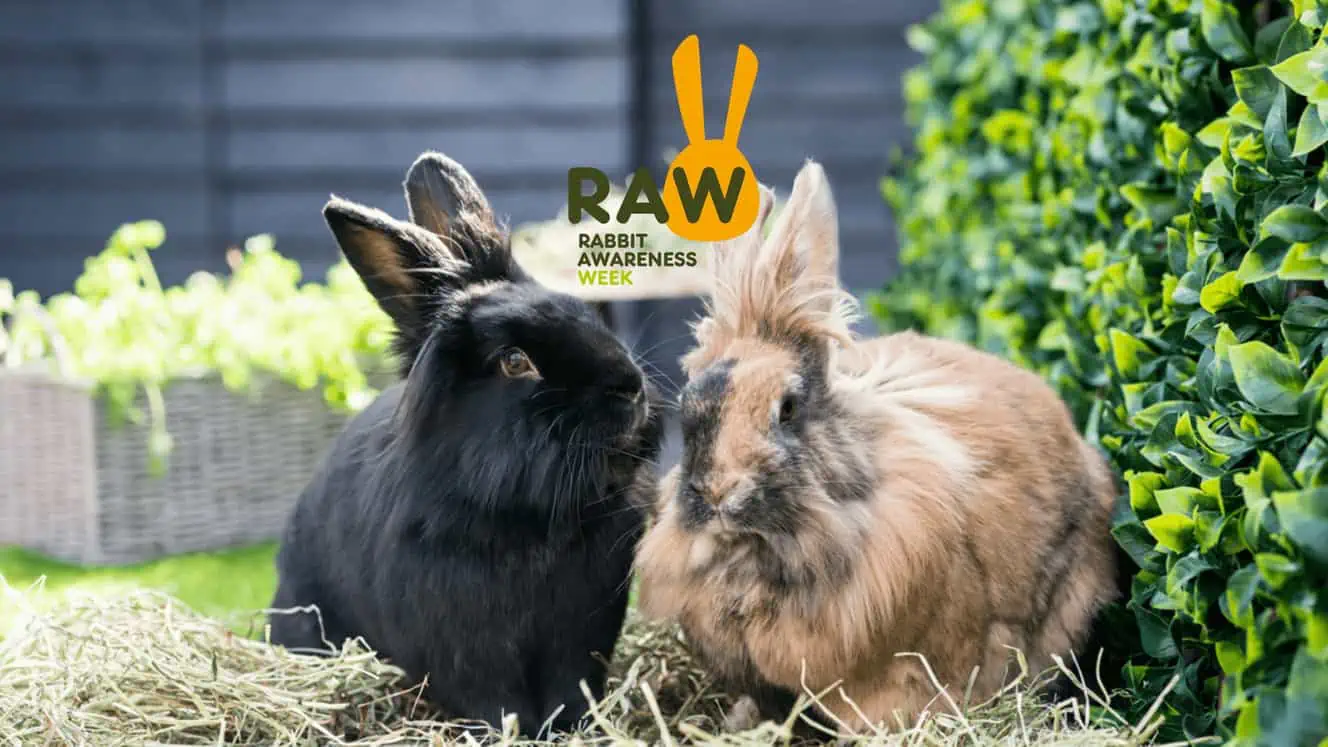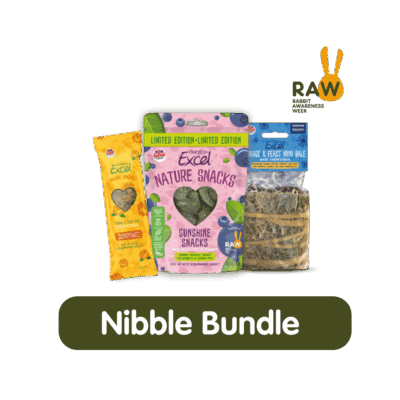
While pet rabbits can happily live indoors or outdoors, when it comes to providing your buns with the best possible environment, rabbit experts agree – the more space you can provide, the happier your rabbits will be. A hutch is simply not enough.
What’s more, that space has to be furnished with a selection of bunny essentials that will enable your fluffy friends to do all the things that come naturally to them, making their house a home.
“Providing your buns with the best possible home means ensuring their 5 welfare needs are met,” advises Burgess in-house vet Dr Suzanne Moyes MVB, MRCVS. “These cover environment, diet, behaviour, companionship and health.”
Find out more about what rabbits really, really want!!! >>
Meeting the 5 WELFARE NEEDS will keep your pet rabbits healthy and happy
1. ENVIRONMENT
- Suitably sized and secure housing
- Constant access to a suitably sized run
- Regular cleaning routine
- Protection from heat or cold
2. DIET
- A suitable, balanced, high fibre diet of hay, nuggets and greens
- Water always available, changed daily
- Minimal and healthy treats
3. BEHAVIOUR
- Sociable and relaxed when handled
- Enrichment items to encourage normal behaviours
4. COMPANY
- Kept in a neutered same species pair or small group
- Good provisions made if owner is away
5. HEALTH
- Body condition score and weight correct
- Neutered and vaccinated
- Healthy teeth
- No evidence of parasites
- Bottom checked daily in warm weather
Bunny home basics
Whether they’re ‘innies’ or ‘outies’, all buns – who should ALWAYS have at least one bunny chum to share their home with – need a multi-levelled, warm and cosy home that features:
- Secluded sleeping spots with clean, dry, soft bedding.
- Enrichment toys such as wicker balls filled with hay for batting about and chewing on.
- Hay racks – pulling out the hay is a great enrichment activity.
- A foraging box – combining some nuggets and wildflower mixes with a pile of feeding hay encourages buns to use their problem-solving skills to forage and find the tasty nibbles.
- Play tunnels – as well as being great for dashing through, tunnels can provide a safe haven to retreat to if your buns feel a bit stressed by something.
- Hiding spaces – as a prey species, hiding is a natural behaviour for bunnies who require safe spaces to conceal themselves whenever they feel the need.
- A digging box – rather than digging up your carpet or your camelias, providing your buns with a dedicated box which you can fill with hay, shredded paper or child-safe sand will give them an outlet to express their natural digging behaviours.
- A water bowl – rabbits naturally lap water, so a sturdy ceramic bowl, regularly cleaned and filled with fresh water daily, is a better option than a water bottle.
- A litter tray – rabbits are very clean animals and can be litter-trained quite easily, making clean-ups quicker and easier.
- Lots of space to exercise – your rabbits’ housing should be permanently attached to a larger space within which they can exercise freely and safely day or night, whether this is a large run outdoors or a safe bunny-proofed room indoors.
Size matters – how big should your rabbits’ accommodation be?
Veterinary charity PDSA advises that 10ft x 6ft x 3ft is the absolute minimum recommended space for a pair of rabbits. Their living space needs to be high and wide enough for them to run around, jump as high as they want, lie down fully stretched out, and stand up on their back legs without their ears touching the top of their accommodation.
Their run area should be at least 3ft high, 6ft wide and 10ft long so that your bunnies can run around as they would do in the wild.
Rabbit Welfare adds: “Let rabbits be rabbits. Think about how rabbits behave in the wild.”
The charity advises that all bunnies need 24/7 access to a safe environment that allows them to:
- Run
- Dig/burrow
- Jump
- Hide
- Forage and graze
- Stretch up on their hind legs
- Lie fully stretched out
- Binky – the adorable playful leap and twist that rabbits make when they are feeling happy, excited and secure
Indoors or outdoors – make your buns home safe and secure and a rewarding place to live
Outdoor buns
When kept outside, your rabbits’ housing should be sturdy, waterproof, well ventilated, raised from the ground to keep them dry on rainy days, and sheltered from the elements, with plenty of warm bedding for them to snuggle into. Your rabbits should have a secure shelter where they can rest and feel safe, and the housing should be safe from predators and escape proof. Make sure they have water, hay and toys, so they don’t get thirsty, hungry or bored, and provide places for them to dig, hide and explore – such as exposed soil, tubes and boxes – and a grassy area so they can nibble as much as they want. Their outdoor home should provide shade to keep them cool on warm days and places to seek cover, to protect them from rain and wind.
Find out more about creating the perfect rabbit environment >>
Indoor buns
All areas that your rabbits move around in should be fully rabbit-proofed to ensure that they are safe and protected from hazards. For example, all electric cables should be covered, and any house plants should either be safe for rabbits or kept out of the way. Also make sure flooring is non-slip as slippy floors can cause rabbits stress. You should have a litter tray for each of your rabbits which is separate from their bedding area. Provide plenty of enrichment. Ideally, give your rabbits access to a secure area outside so that they can dig and graze on grass. If this isn’t possible, the next best thing is to provide ‘dig-boxes’ filled with earth or child-safe sand and pots with growing grass in.
How to be a gold-star indoor bunny owner >>
Good housekeeping will keep things clean and hygienic
Keeping your rabbits’ home clean, tidy and hygienic will discourage pests from making an unwanted appearance and help keep your bunny chums healthy and happy.
- DAILY Give your rabbits’ housing a quick clean every day, throwing out wet/dirty bedding, uneaten food and cleaning and refilling food and drink containers.
- WEEKLY Give the housing a thorough clean, removing and replacing all bedding.
- MONTHLY Give your rabbits’ housing a ‘deep clean’ where you take everything out, scrub the housing with an animal-safe cleaner then replace bedding with fresh hay. Always keep a little of the old, clean hay back and replace it after cleaning so the place smells like home!
NUTRITIOUS FOOD FOR HEALTHY, HAPPY RABBITS – 92% OF UK VETS RECOMMEND OUR BURGESS EXCEL SMALL PETS RANGE!
Rabbits are herbivores and need a plant-based diet with lots of fibre to keep their digestive system healthy. Along with their rabbit nuggets and a few healthy treats make sure your rabbits have unlimited access to good quality, dust extracted feeding hay and fresh grass (but not grass cuttings) to graze on.
Check out our tasty nugget varieties specially created for junior and dwarf rabbits, indoor bunnies, golden oldies, adult rabbits – there’s even a light recipe for buns who are watching their weight! Rabbit nuggets – how to choose what’s best for your buns >>
LET’S GET SOCIAL! Sign up to the Excel Bunny Base – a safe Facebook community for rabbit guardians that are looking for advice and friendly discussions from likeminded owners – and there are lots of cute bunny photos and videos! Also join us on Instagram.
If you found this interesting, you may also like:
HOW TO HELP YOUR BUNNIES GET ALL THE EXERCISE THEY NEED To encourage your bunny chums to like to move it, move it, create an exciting space where they can hop, run, jump, explore and forage.
21 AMAZING RABBIT FACTS FOR BUNNY FANATICS Even if you’re a lifelong bunny lover, there are a few things you may not know about your hay-chomping chums.
BONDING WITH YOUR BUNNY CHUMS Whether your buns are already part of the family, or you’ve just welcomed some new rabbits into your family, find out how to deepen your connection with your nose-twitching pals.
GAMES TO PLAY WITH YOUR RABBITS Bunnies are smart and active creatures who like lots of things to do and games to play – particularly if there are some tasty rabbit treats involved. We’ve some fun ideas to add interest and excitement to your buns’ day.
WONDERFUL WAYS WITH HAY Rabbits need lots of fresh hay every day to keep them healthy. But did you know, hay can also make them happy?
BUNNY TALK Rabbits have a complex language all of their own. By learning to understand their body postures, behaviours and vocalisations, you’ll uncover their individual personalities.
DO YOUR SMALL PETS HAVE THE RIGHT TO ROAM? Find out why giving small furries the chance to scamper about in a safe, enriching space is essential to their health and wellbeing.
WHAT’S THE BEST BEDDING FOR SMALL PETS? Whichever small pets you have, each has different requirements when it comes to creating a cosy, safe snoozing spot.
THE SUN CAN BE FUN BUT OUR PETS NEED TO KEEP IT COOL Glorious sunny days give both people and pets a much-needed boost. However, it also means taking precautions as scorchingly high temperatures can cause all sorts of problems for our pet friends.
SMALL FURRIES NEED A SECOND CHANCE TOO As well as taking on a rescue dog or adopting a cat from an animal sanctuary, did you know that there are lots of small furries in rescue centres around the country that are looking for loving homes?
WHAT PUTS YOUR SMALL PETS IN A GOOD MOOD? Along with socialising with their same species companion and interacting with their favourite human, our survey reveals the best thing you can to do to give your small furries a happiness boost…
LITTER TRAINING YOUR RABBITS Whether your buns live indoors or out, litter training has lots of benefits – both for them and you!
HOW DO YOU GROOM RABBITS? Keeping clean and neat is very important to rabbits and, just like cats, buns spend a huge amount of time grooming themselves. They also need a little help from us.
WHICH POPULAR RABBIT BREEDS HAVE THE MOST HEALTH ISSUES? ‘Cute’ bunny breeds such as the Lionhead rabbit, the Netherland Dwarf rabbit and the Mini Lop, are at risk from long-term health problems.
RABBITS AND GUINEA PIGS – IS INDOORS OR OUTDOORS BEST? Is the outdoor life better for bunnies and guinea pigs, or will these small pets have a more enriching time if they’re kept indoors?
INDOOR GUINEA PIGS AND HOUSE BUNNIES Once traditionally always housed outdoors, many people enjoy keeping their guinea pigs or rabbits as indoor pets – and there are all sorts of reasons why.
FINDING A VET FOR YOUR SMALL PETS Did you know that just like hospital specialists, vets have different areas of expertise? That’s why, if you have small pets, it can be a good idea to seek out a vet that specialises in small animal medicine.
PET INSURANCE EXPLAINED Can you get pet insurance for pre-existing conditions? Can you get pet insurance for older pets? Can you get multi-pet cover? We answer some of the most commonly asked questions to help you make an informed decision.

















